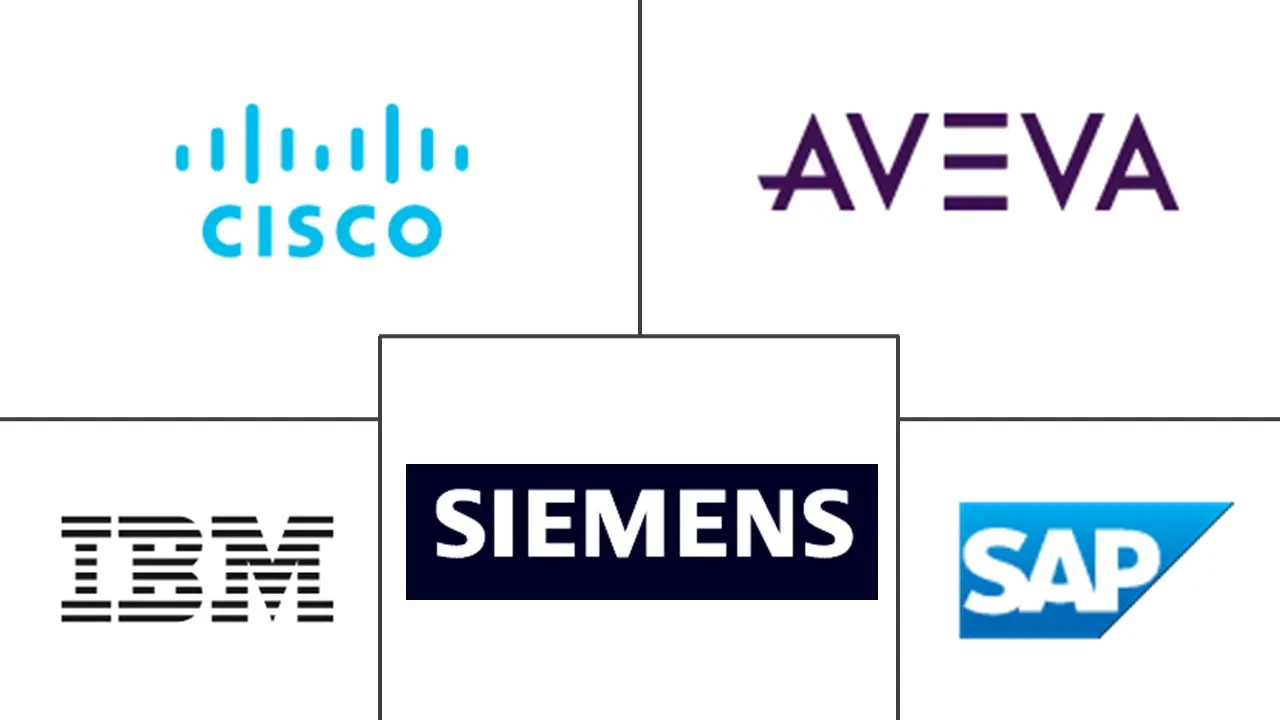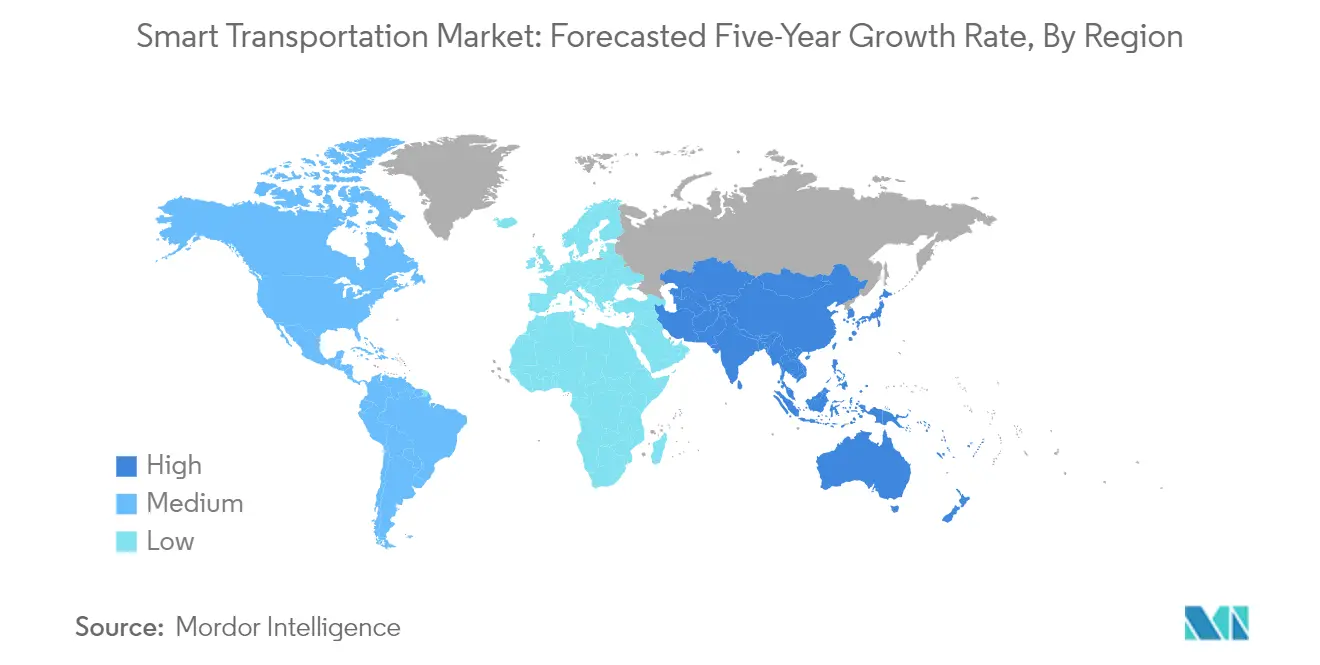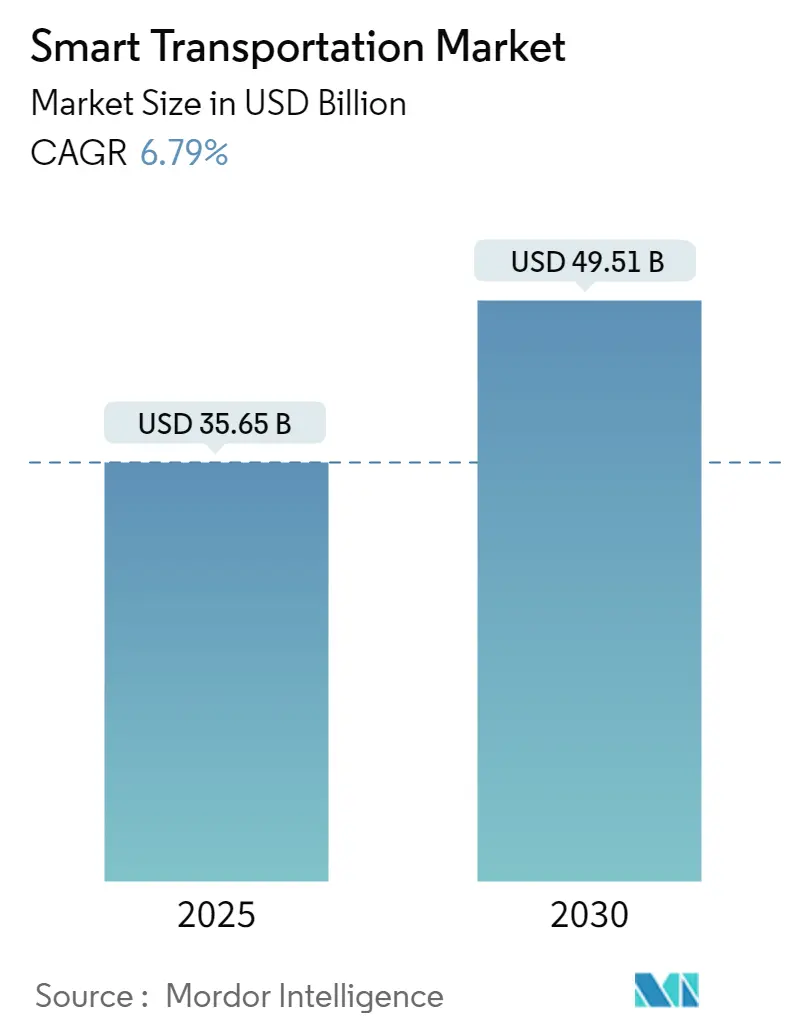
Smart Transportation Market Analysis
The Smart Transportation Market size is estimated at USD 35.65 billion in 2025, and is expected to reach USD 49.51 billion by 2030, at a CAGR of 6.79% during the forecast period (2025-2030).
The smart transportation landscape is undergoing a significant transformation driven by technological advancement and increasing urban challenges. The integration of the Internet of Things (IoT), artificial intelligence, and advanced communication technologies is reshaping how cities approach transportation management and smart infrastructure development. According to United Nations forecasts, more than 70% of the world's population will be urbanized by 2030, with India alone expected to have 700 million people residing in cities. This demographic shift is compelling cities worldwide to adopt intelligent transport system solutions that can effectively manage increasing traffic volumes while ensuring sustainable smart mobility.
The industry is witnessing a substantial evolution in traffic management capabilities through the implementation of advanced technologies. Modern traffic management systems are incorporating artificial intelligence and machine learning to optimize traffic flow, reduce congestion, and enhance safety. This technological progression is particularly crucial given that in 2022, the average American motorist wasted 51 hours in traffic congestion, costing approximately USD 869 in lost time according to Inrix's Global Traffic Scorecard. The integration of transportation IoT, smart sensors, real-time data analytics, and automated traffic control systems is enabling cities to respond more effectively to changing traffic patterns and reduce such inefficiencies.
The market is experiencing a significant shift towards integrated mobility solutions that combine various transportation modes into a seamless network. Cities are increasingly adopting smart ticketing systems, real-time passenger information systems, and multimodal transportation platforms to enhance the commuter experience. The industry projection indicates that by 2025, more than 26 smart city transportation initiatives will emerge, predominantly in North America and Europe, driving the adoption of AI and IoT technologies in urban mobility solutions. This integration is facilitating more efficient journey planning, reducing transit times, and improving the overall reliability of public transportation systems.
The sector is witnessing rapid advancement in vehicle-to-everything (V2X) communication technologies and cooperative intelligent transport system developments. These advancements are enabling enhanced communication between vehicles, infrastructure, and other road users, leading to improved traffic efficiency and safety. The implementation of smart transportation solutions is also focusing on environmental sustainability, with cities prioritizing the development of eco-friendly transportation options and intelligent traffic management systems that can help reduce carbon emissions. By 2040, cities are expected to accommodate 65% of the world's population, making these technological advancements crucial for future digital transportation and transportation automation in urban mobility management.
Smart Transportation Market Trends
Rise of Urbanization, Increasing Megacities, and Growing Population
The unprecedented pace of global urbanization, coupled with population growth and the emergence of megacities, is fundamentally transforming urban mobility needs worldwide. According to the Population Reference Bureau, the global urbanization rate reached 57% in 2022, with North America leading at over four-fifths of its population residing in urban areas. This massive urban concentration has created complex mobility challenges, particularly in Asia, where countries like India and China already have approximately a billion people living in cities alone. The rapid expansion of urban areas has led to increased pressure on existing smart infrastructure, creating an urgent need for smart transportation solutions to manage traffic flow, reduce congestion, and improve overall mobility efficiency.
The scale of urbanization is expected to intensify further, with the United Nations projecting that urban areas will house 68% of the global population by 2050. This demographic shift is creating unprecedented challenges for city planners and transportation authorities, as urban residents increasingly demand transportation systems that are fast, efficient, affordable, safe, and environmentally friendly. The emergence of megacities has brought additional complications, including severe traffic congestion, critical safety concerns, and growing urban inequality. These challenges are compelling cities worldwide to integrate intelligence into their existing transportation systems, as traditional infrastructure solutions alone can no longer adequately address the complex smart mobility needs of rapidly growing urban populations.
Government Initiatives to Enhance Transportation Infrastructure
Governments across the globe are implementing comprehensive policy frameworks and investment programs to modernize transportation infrastructure through smart transportation solutions. A prime example is China's 14th Five-Year Plan (2021-2025), which outlines an ambitious roadmap for developing an intelligent and green transportation system, focusing on improving overall service quality, competence, and efficiency across various transportation modes including roads, trains, ports, and waterways. These government initiatives are increasingly emphasizing the integration of advanced technologies such as IoT architecture, cloud computing, sensors, and data communication systems to create more responsive and efficient transportation networks.
International collaboration in transportation infrastructure development has become a key driver for market growth, as evidenced by significant cross-border initiatives. For instance, in December 2022, a landmark agreement between India and South Korea saw the commitment of INR 1,495 crore from the Economic Development Cooperation Fund (EDCF) for constructing an intelligent transportation system on the Nagpur-Mumbai Expressway. Such collaborative efforts are becoming increasingly common as governments recognize the need for expertise and resource sharing in developing sophisticated transportation solutions. These initiatives are particularly prominent in emerging economies, where governments are actively pursuing smart city transportation developments and implementing intelligent technologies to enhance traffic efficiencies and overall transportation infrastructure quality.
Segment Analysis: By Application
Traffic Management Segment in Smart Transportation Market
The smart traffic management segment has emerged as the dominant force in the smart transportation market, commanding approximately 37% market share in 2024. This segment's leadership position is driven by the increasing adoption of route-guiding systems, smart traffic signals, and the incorporation of CCTV cameras to provide real-time information. The segment's prominence is further strengthened by its role in addressing critical urban challenges like traffic congestion, optimizing road infrastructure usage, and enhancing overall traffic flow efficiency. With the highest growth rate of around 8% expected during 2024-2029, this segment continues to evolve with the integration of artificial intelligence and advanced analytics for predictive traffic management, automated incident detection, and dynamic signal control systems. The implementation of Advanced Transportation Management Systems (ATMS) across major cities worldwide has been instrumental in maintaining this segment's market leadership.
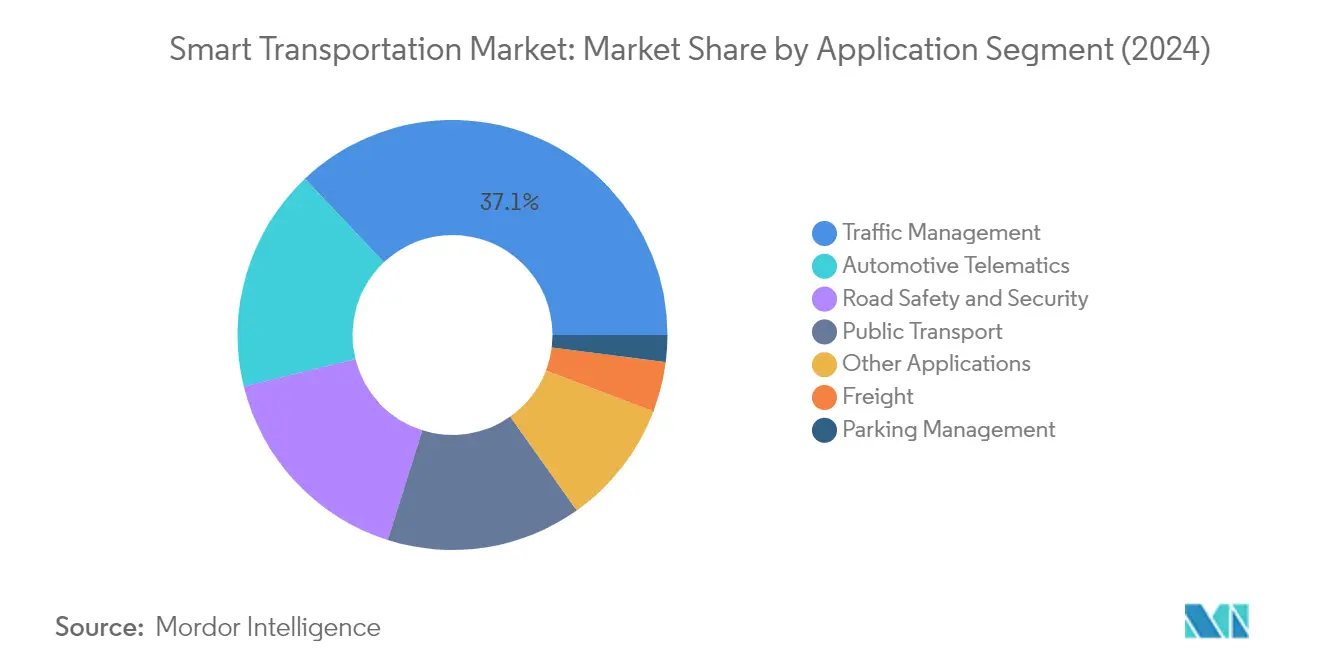
Remaining Segments in Smart Transportation Market by Application
The smart transportation market encompasses several other vital segments that contribute to its comprehensive ecosystem. Automotive Telematics plays a crucial role in vehicle-to-vehicle and vehicle-to-infrastructure communication, while Road Safety and Security focuses on accident prevention and emergency response systems. The Public Transport segment emphasizes improving mass transit efficiency and passenger experience through real-time information systems and smart ticketing solutions. Smart parking solutions address urban parking challenges through smart sensors and automated systems, while the Freight segment focuses on optimizing logistics and supply chain operations. Each of these segments contributes uniquely to the overall market dynamics, with varying levels of technological integration and implementation across different regions and urban environments.
Segment Analysis: By Product Type
Advanced Transportation Management Systems Segment in Smart Transportation Market
The Advanced Transportation Management System (ATMS) segment dominates the smart transportation market, holding approximately 36% market share in 2024. This segment's leadership position is driven by the increasing adoption of cloud-based SaaS solutions and the exponential growth of the e-commerce industry requiring sophisticated transportation management. ATMS solutions are particularly crucial for addressing the rising customer expectations for on-time deliveries, including same-day delivery services, with real-time updates throughout the shipment process. The segment's growth is further supported by the integration of artificial intelligence and machine learning technologies, enabling more efficient traffic flow management and automated decision-making processes in transportation networks.
Advanced Public Transportation Systems Segment in Smart Transportation Market
The Advanced Public Transportation Systems (APTS) segment is projected to experience the highest growth rate of approximately 8% during the forecast period 2024-2029. This remarkable growth is attributed to the increasing need to manage public transportation with rising population densities and ongoing investments from various government organizations to improve public transport operations. APTS technologies, including automatic vehicle location systems, passenger information systems, and automatic passenger counting systems, are being rapidly adopted by transit agencies worldwide. The segment's growth is further driven by the integration of IoT-based solutions and real-time data analytics, enabling transit managers and passengers to access up-to-date information about journeys, vehicles, and network conditions.
Remaining Segments in Smart Transportation Market by Product Type
The remaining segments in the smart transportation market include Advanced Transportation Pricing Systems (ATPS), Advanced Traveler Information Systems (ATIS), and Cooperative Vehicle Systems. ATPS plays a crucial role in implementing electronic toll collection and congestion pricing mechanisms, while ATIS focuses on providing real-time travel information and route guidance to travelers. The Cooperative Vehicle Systems segment, though smaller, is significant in enabling vehicle-to-vehicle and vehicle-to-infrastructure communications. These segments collectively contribute to creating a comprehensive smart transportation ecosystem, addressing various aspects from pricing and information dissemination to vehicle communication and coordination.
Smart Transportation Market Geography Segment Analysis
Smart Transportation Market in North America
North America represents one of the most technologically advanced markets for smart transportation solutions, driven by extensive infrastructure development and early adoption of innovative technologies. The United States and Canada are making significant strides in implementing intelligent transportation systems, with a particular focus on traffic management, road safety, and public transport optimization. The region's growth is supported by substantial government investments in smart infrastructure modernization and the presence of major technology providers who are continuously innovating in areas such as autonomous vehicles, connected infrastructure, and smart traffic management systems.
Smart Transportation Market in United States
The United States leads the North American smart transportation market with approximately 86% market share in 2024, establishing itself as the dominant force in smart transportation innovation. The country's smart transportation landscape is characterized by extensive implementation of advanced traffic management systems and intelligent transportation solutions across major metropolitan areas. Cities across the nation are actively deploying smart traffic signal systems, connected vehicle technologies, and advanced public transportation solutions. The U.S. Department of Transportation's continued focus on modernizing infrastructure through various funding initiatives has created a robust ecosystem for smart transportation development, particularly in areas such as autonomous vehicle testing, intelligent traffic management, and connected infrastructure deployment.
Smart Transportation Market in Canada
Canada emerges as the fastest-growing market in North America with a projected growth rate of approximately 8% during 2024-2029. The country's smart transportation sector is witnessing rapid evolution through the integration of advanced technologies in its transportation infrastructure. Canadian cities are increasingly adopting smart mobility solutions, with particular emphasis on sustainable transportation systems and electric vehicle infrastructure. The government's commitment to reducing carbon emissions through smart transportation initiatives, coupled with strong support for technological innovation in the transportation sector, is driving this growth. Major cities across Canada are implementing comprehensive smart city plans that prioritize intelligent transportation systems as a key component of urban development.
Smart Transportation Market in Europe
Europe stands at the forefront of smart transportation innovation, with countries across the region implementing advanced mobility solutions and sustainable transportation initiatives. The United Kingdom, Germany, and France are leading the charge in developing and implementing cutting-edge transportation technologies. The region's commitment to reducing carbon emissions and improving urban mobility has resulted in widespread adoption of smart transportation solutions, ranging from intelligent traffic management systems to advanced public transportation networks. European cities are particularly focused on integrating various modes of transportation through smart mobility platforms and developing sustainable urban transportation solutions.
Smart Transportation Market in United Kingdom
The United Kingdom maintains its position as the largest smart transportation market in Europe, commanding approximately 29% of the regional market share in 2024. The country's smart transportation initiatives are characterized by comprehensive implementation of intelligent traffic management systems and innovative mobility solutions across major cities. British authorities are actively promoting the development of autonomous vehicle technologies, smart parking solutions, and integrated public transportation systems. The government's commitment to modernizing transportation infrastructure through various funding programs and regulatory frameworks has created a favorable environment for smart transportation development.
Smart Transportation Market in France
France demonstrates the highest growth potential in the European smart transportation market, with a projected growth rate of approximately 8% during 2024-2029. The country's approach to smart transportation is marked by significant investments in innovative mobility solutions and sustainable transportation infrastructure. French cities are increasingly adopting advanced traffic management systems, smart public transportation solutions, and electric mobility initiatives. The government's strong focus on developing smart city infrastructure, coupled with initiatives to promote sustainable urban mobility, is driving the rapid growth of smart transportation solutions across the country.
Smart Transportation Market in Asia-Pacific
The Asia-Pacific region represents a dynamic market for smart transportation solutions, characterized by rapid urbanization and increasing adoption of advanced transportation technologies. Countries like China, Japan, and Australia are leading the implementation of smart transportation systems, each bringing unique approaches to addressing their transportation challenges. The region's focus on developing smart cities and sustainable urban mobility solutions has created a robust ecosystem for smart transportation innovation. Governments across the region are actively promoting the adoption of intelligent transportation systems through various initiatives and partnerships with technology providers.
Smart Transportation Market in China
China stands as the largest market for smart transportation in the Asia-Pacific region, demonstrating remarkable progress in implementing comprehensive smart transportation solutions. The country's approach to smart transportation is characterized by large-scale deployment of artificial intelligence, Internet of Things, and 5G technologies in transportation systems. Chinese cities are at the forefront of implementing advanced traffic management systems, smart public transportation solutions, and innovative mobility platforms. The government's strong support for smart city initiatives and technological innovation continues to drive the expansion of smart transportation infrastructure across the country.
Smart Transportation Market in China - Growth Leader
China also emerges as the fastest-growing market in the Asia-Pacific region, driven by aggressive implementation of smart transportation technologies and substantial government investments in transportation infrastructure. The country's rapid advancement in areas such as autonomous vehicles, smart traffic management systems, and integrated transportation platforms is reshaping urban mobility. Chinese cities are increasingly adopting cutting-edge technologies to address transportation challenges, with particular emphasis on artificial intelligence and big data analytics in transportation management. The government's commitment to technological innovation and sustainable urban development continues to accelerate the adoption of smart transportation solutions.
Smart Transportation Market in Latin America
Latin America's smart transportation market is experiencing significant transformation, with countries across the region implementing various intelligent transportation solutions to address urban mobility challenges. Brazil and Mexico are leading the regional market, with Brazil emerging as both the largest and fastest-growing market in the region. The region's focus on modernizing public transportation systems and implementing smart traffic management solutions is driving market growth. Governments across Latin America are increasingly partnering with technology providers to implement smart transportation solutions, particularly in major metropolitan areas where traffic congestion and urban mobility are significant challenges.
Smart Transportation Market in Middle East & Africa
The Middle East & Africa region demonstrates growing adoption of smart transportation solutions, with countries like the United Arab Emirates, Saudi Arabia, and South Africa leading the implementation of intelligent transportation systems. The UAE emerges as the fastest-growing market, while Saudi Arabia maintains its position as the largest market in the region. The region's focus on developing smart cities and modernizing transportation infrastructure is driving the adoption of smart transportation solutions. Countries across the region are investing in advanced traffic management systems, smart public transportation solutions, and innovative mobility platforms as part of their broader smart city initiatives.
Smart Transportation Industry Overview
Top Companies in Smart Transportation Market
The smart transportation companies market features prominent technology leaders like Cisco Systems, SAP SE, IBM Corporation, AVEVA Group, Siemens Corporation, Oracle Corporation, Alstom, Advantech Co., Orange SA, Huawei Technologies, and Hitachi Ltd. These companies are driving innovation through advanced technologies, including artificial intelligence, IoT, cloud computing, and 5G integration in transportation solutions. The smart transportation industry demonstrates a strong focus on product development, with companies investing heavily in R&D to create comprehensive mobility platforms and intelligent infrastructure solutions. Operational agility is evident through the increasing adoption of hybrid cloud platforms, software-defined networks, and edge computing capabilities. Strategic partnerships and collaborations, particularly between technology providers and transportation authorities, have become crucial for market expansion. Companies are also focusing on geographical expansion through localized solutions while maintaining global standardization of their core offerings.
Dynamic Market Structure Drives Industry Evolution
The smart transportation industry exhibits a complex competitive structure characterized by both global technology conglomerates and specialized transportation solution providers. Large multinational corporations like IBM, Siemens, and Huawei leverage their extensive technological capabilities and global presence to offer end-to-end smart transportation solutions, while specialized players like Alstom focus on specific segments such as rail transportation. The market shows moderate consolidation, with major players controlling significant market share through their established platforms and solutions, though regional players maintain strong positions in their respective territories through localized expertise and government relationships.
The industry is witnessing increased merger and acquisition activities as companies seek to enhance their technological capabilities and expand their geographical footprint. Technology giants are acquiring specialized transportation software and hardware providers to strengthen their vertical integration capabilities. Strategic partnerships between infrastructure providers, software developers, and local transportation authorities are becoming increasingly common, creating integrated ecosystems that combine technological expertise with operational experience. This collaborative approach is reshaping the competitive landscape by enabling more comprehensive and efficient intelligent transport system solutions.
Innovation and Integration Drive Future Success
Success in the smart transportation market increasingly depends on companies' ability to deliver integrated, scalable solutions that address evolving mobility needs. Market leaders are focusing on developing platform-based approaches that combine cloud infrastructure, data analytics, and artificial intelligence to provide comprehensive transportation management system solutions. The ability to offer customizable solutions while maintaining standardization across different geographical markets has become crucial. Companies are also investing in cybersecurity capabilities and regulatory compliance frameworks to address growing concerns about data protection and system reliability.
For new entrants and emerging players, success lies in identifying and exploiting specific market niches while building strategic partnerships with established players. The concentration of end-users, primarily government agencies and large transportation operators, necessitates strong relationship management capabilities and proven track records in project delivery. While substitution risk remains low due to the essential nature of transportation infrastructure, companies must continuously innovate to address changing mobility patterns and sustainability requirements. Regulatory frameworks, particularly around data privacy and environmental standards, are becoming increasingly important factors in shaping competitive strategies, requiring companies to maintain flexible and adaptable business models. The smart mobility industry, connected vehicle industry, and connected car industry are also pivotal in driving future growth and innovation within the sector.
Smart Transportation Market Leaders
-
Cisco Systems Inc.
-
SAP SE
-
IBM Corporation
-
AVEVA Group PLC
-
Siemens Corporation
- *Disclaimer: Major Players sorted in no particular order
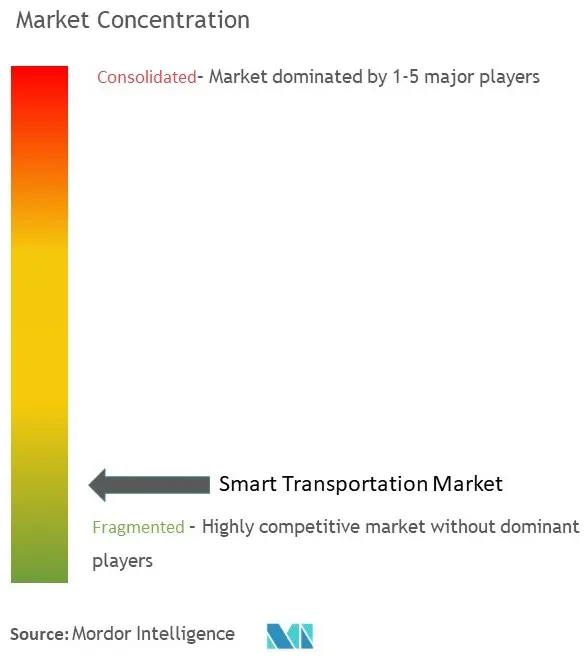
Smart Transportation Market News
- November 2023 – Hitachi ZeroCarbon Ltd. has partnered with FirstGroup plc to lead the UK's shift to electric buses. The collaboration, which is part of FirstGroup's bus fleet and infrastructure decarbonisation programme, will provide batteries for First Bus's expanding electric bus fleet, helping to make a positive impact on air quality, tackle congestion and improve customer experience.
- August 2023 - NEC India partners with Mowasalat for smart transportation in Qatar, Enabling travel solutions to people attending tournament in Qatar, the implementation of ITMS for Tournament Bus Service (TBS), and help enable best-in-class public transportation experience to millions of Football admirers from all over the world.
Smart Transportation Market Report - Table of Contents
1. INTRODUCTION
- 1.1 Study Assumptions and Market Definition
- 1.2 Scope of the Study
2. RESEARCH METHODOLOGY
3. EXECUTIVE SUMMARY
4. MARKET INSIGHTS
- 4.1 Market Overview
-
4.2 Industry Attractiveness - Porter's Five Forces Analysis
- 4.2.1 Bargaining Power of Suppliers
- 4.2.2 Bargaining Power of Buyers
- 4.2.3 Threat of New Entrants
- 4.2.4 Intensity of Competitive Rivalry
- 4.2.5 Threat of Substitute Products
- 4.3 Industry Value Chain Analysis
- 4.4 Impact of Macroeconomic Trends on the Market
- 4.5 Technology Snapshot
5. MARKET DYNAMICS
-
5.1 Market Drivers
- 5.1.1 Rise of Urbanization and Increasing Mega Cities and Increasing Population
- 5.1.2 Government Initiatives to Enhance the Transportation Infrastructure
-
5.2 Market Restraints
- 5.2.1 High Capital Required for Deployment
6. MARKET SEGMENTATION
-
6.1 By Application
- 6.1.1 Traffic Management
- 6.1.2 Road Safety and Security
- 6.1.3 Parking Management
- 6.1.4 Public Transport
- 6.1.5 Automotive Telematics
- 6.1.6 Freight
- 6.1.7 Other Applications
-
6.2 By Product Type
- 6.2.1 Advanced Traveler Information Systems (ATIS)
- 6.2.2 Advanced Transportation Management Systems (ATMS)
- 6.2.3 Advanced Transportation Pricing Systems (ATPS)
- 6.2.4 Advanced Public Transportation Systems (APTS)
- 6.2.5 Cooperative Vehicle Systems
-
6.3 By Geography***
- 6.3.1 North America
- 6.3.1.1 United States
- 6.3.1.2 Canada
- 6.3.2 Europe
- 6.3.2.1 United Kingdom
- 6.3.2.2 Germany
- 6.3.2.3 France
- 6.3.3 Asia
- 6.3.3.1 China
- 6.3.3.2 Japan
- 6.3.4 Australia and New Zealand
- 6.3.5 Latin America
- 6.3.5.1 Mexico
- 6.3.5.2 Brazil
- 6.3.6 Middle East and Africa
- 6.3.6.1 United Arab Emirates
- 6.3.6.2 South Africa
- 6.3.6.3 Saudi Arabia
7. COMPETITIVE LANDSCAPE
-
7.1 Company Profiles*
- 7.1.1 Cisco Systems Inc.
- 7.1.2 SAP SE
- 7.1.3 IBM Corporation
- 7.1.4 AVEVA Group PLC
- 7.1.5 Siemens Corporation
- 7.1.6 Oracle Corporation
- 7.1.7 Alstom
- 7.1.8 Advantech Co. Ltd
- 7.1.9 Orange SA
- 7.1.10 Huawei Technologies Co. Ltd
- 7.1.11 Hitachi Ltd
8. INVESTMENT ANALYSIS
9. FUTURE OF THE MARKET
Smart Transportation Industry Segmentation
Smart transport or intelligent transport is an advanced transportation infrastructure that aims to provide innovative traveler information systems, transportation management systems, transportation pricing systems, public transportation systems, and cooperative vehicle systems. It has various applications, such as traffic management, safety and security, parking management, public transport, automotive telematics, and freight.
The study also tracks the demand for the global smart transportation market based on application, product type in multiple geographies. The impact of macroeconomic trends on the market is also covered under the scope of the study. Further, the disturbance of the factors affecting the Market's evolution in the near future has been covered in the study regarding drivers and constraints. The market sizes and predictions are provided in terms of value in USD for all the above segments.
| By Application | Traffic Management | ||
| Road Safety and Security | |||
| Parking Management | |||
| Public Transport | |||
| Automotive Telematics | |||
| Freight | |||
| Other Applications | |||
| By Product Type | Advanced Traveler Information Systems (ATIS) | ||
| Advanced Transportation Management Systems (ATMS) | |||
| Advanced Transportation Pricing Systems (ATPS) | |||
| Advanced Public Transportation Systems (APTS) | |||
| Cooperative Vehicle Systems | |||
| By Geography*** | North America | United States | |
| Canada | |||
| Europe | United Kingdom | ||
| Germany | |||
| France | |||
| Asia | China | ||
| Japan | |||
| Australia and New Zealand | |||
| Latin America | Mexico | ||
| Brazil | |||
| Middle East and Africa | United Arab Emirates | ||
| South Africa | |||
| Saudi Arabia | |||
Smart Transportation Market Research FAQs
How big is the Smart Transportation Market?
The Smart Transportation Market size is expected to reach USD 35.65 billion in 2025 and grow at a CAGR of 6.79% to reach USD 49.51 billion by 2030.
What is the current Smart Transportation Market size?
In 2025, the Smart Transportation Market size is expected to reach USD 35.65 billion.
Who are the key players in Smart Transportation Market?
Cisco Systems Inc., SAP SE, IBM Corporation, AVEVA Group PLC and Siemens Corporation are the major companies operating in the Smart Transportation Market.
Which is the fastest growing region in Smart Transportation Market?
Asia Pacific is estimated to grow at the highest CAGR over the forecast period (2025-2030).
Which region has the biggest share in Smart Transportation Market?
In 2025, the Europe accounts for the largest market share in Smart Transportation Market.
What years does this Smart Transportation Market cover, and what was the market size in 2024?
In 2024, the Smart Transportation Market size was estimated at USD 33.23 billion. The report covers the Smart Transportation Market historical market size for years: 2019, 2020, 2021, 2022, 2023 and 2024. The report also forecasts the Smart Transportation Market size for years: 2025, 2026, 2027, 2028, 2029 and 2030.
Our Best Selling Reports
Smart Transportation Market Research
Mordor Intelligence provides a comprehensive analysis of the smart transportation industry. We leverage our extensive expertise in intelligent transport system research and consulting. Our detailed report examines the evolution of transportation IoT solutions. This includes smart ticketing, smart parking, and smart logistics systems. The analysis covers emerging technologies like connected vehicles and smart mobility solutions. We focus particularly on transportation management systems and smart infrastructure. Our research is available as an easy-to-read report PDF for download, offering detailed insights into smart railway implementations and smart road technologies.
The report offers stakeholders valuable insights into mobility as a service trends, urban mobility patterns, and smart fleet management solutions. Our analysis covers crucial developments in transportation analytics, smart traffic management, and autonomous transportation systems. The comprehensive coverage includes a detailed examination of smart public transportation initiatives, transportation automation developments, and smart city transportation solutions. Stakeholders benefit from our thorough analysis of connected car technologies, digital transportation innovations, and smart transit systems. This is supported by robust data and actionable insights for informed decision-making.

